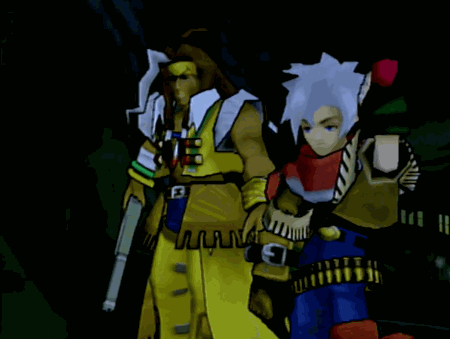 As of Chapter 1 finishing, let us enjoy a brief interlude on the nature of Wild Arms 3. And we shall do this on July 25, Scarecrow Day. In Elw architecture, scarecrows are commonly placed on rooftops in place of weathercocks. But it was rumored to bring bad luck among non-Elws and slowly went out of style. A scarecrow slowly rotting away into dust is a sad sight.
As of Chapter 1 finishing, let us enjoy a brief interlude on the nature of Wild Arms 3. And we shall do this on July 25, Scarecrow Day. In Elw architecture, scarecrows are commonly placed on rooftops in place of weathercocks. But it was rumored to bring bad luck among non-Elws and slowly went out of style. A scarecrow slowly rotting away into dust is a sad sight.
Controversial statement: they do not make JRPGs anymore.
So here is how I’ve always seen the evolution of the JRPG. You start with Dragon Warrior/Quest. You move over to Final Fantasy. Over the span of the Nintendo Entertainment System, Final Fantasy evolves out of sight of Americans from simple nonsense with six characters (who must only be four characters) to a sprawling story of flying continents and children working multiple vocations just to make (airship) ends meet. Over in Dragon land, we actually saw the evolution from Hero venturing out alone into the wilderness, to gaining a party of companions, to gaining more “job” options than you could shake a Falcon Blade at, and finally reaching Dragon Warrior/Quest 4. That final title seems relevant, as in addition to utilizing all the advantages that had been granted to its forebearers, Dragon Warrior 4 told an epic, chapter-based story that included memorable, distinct characters all living their best lives in defiance of a hellish (but maybe misunderstood!) villain. While there are inevitably other examples, let us use 1990’s Dragon Quest 4 as the benchmark for how JRPG went from “inhabit these heroes and guide them on their quest” to something more akin to “sure, saving the world is great, but wouldn’t you like to know what happens next for your good buddy Torneko Taloon?”
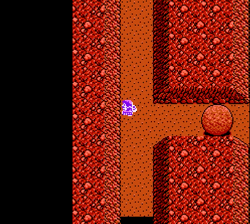
And then, a year later, we had Final Fantasy 4. Far beyond Dragon Quest 4, FF4 was the ceiling for videogame storytelling. The world is in danger! But so is your hero’s girlfriend! Brother is betraying brother! People are dying! And, even more important than said story was that all of this action was presented with… action. The twins make their noble sacrifice while the walls are actively closing in on you (and later battles remind you how difficult it is to fight a wall). Yang is blasted into amnesia while frantically trying to stop a cannon manned by goblins. And Cid does not simply lay a few charges to close the entrance to the underground, he actively jumps out of an airship and detonates his bearded ass. In short, whereas JRPGs and videogames in general had had dramatic moments before, Final Fantasy 4 went out of its way to present a story that was, more often than not, actively including as many explosions as possible.

And then, in 1997, we got to Final Fantasy 7. After a console generation of JRPG luminaries (in multiple ways), Final Fantasy 7 could be presented as the pinnacle of the genre. Ignore the remake (as good as it may be), and go back and play OG FF7. Marvel at how much and how often something happens. You cannot so much as traipse through a forgotten mountain pass without having a brief discussion on chocobo hair. And while Tifa is talking to Cloud about grooming tips, there is movement. There are great graphics (for the era, natch). There are gorgeous environments. Combine these elements, and you are continually presented with an engaging story that incidentally has an amazing presentation. Final Fantasy 7 was primarily remembered for its FMVs, but it is the minute-to-minute performance that keeps a player engaged across three discs.
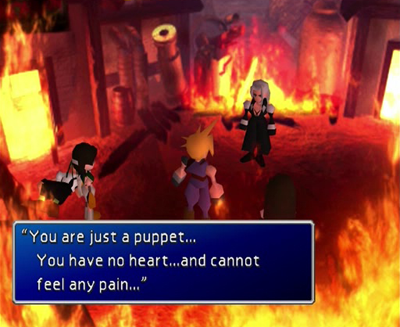
But by the time the Playstation 2 rolled into living rooms, the great divergence occurred. On one hand, you had Final Fantasy 10…
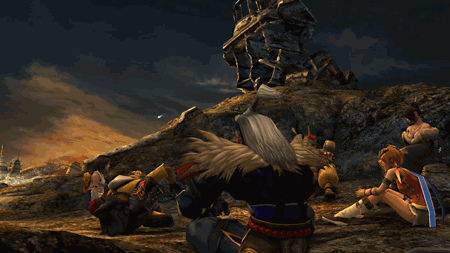
Final Fantasy 10 was, for all intents and purposes, a playable movie. There was voice acting. There was motion capture. And the end result is something that is just as engaging as a movie… because it basically is a movie. And, starting in 2001, if your company was making a JRPG, you had the choice to make that playable movie. You could chase the JRPG zeitgeist, and, whether you were continuing the Xeno-franchise or recruiting Studio Ghibli into your production, you could make a Hollywood blockbuster out of your JRPG. The only downside to this was that it cost more than a couple of bucks to make such a thing presentable. If you didn’t feel like doing that…
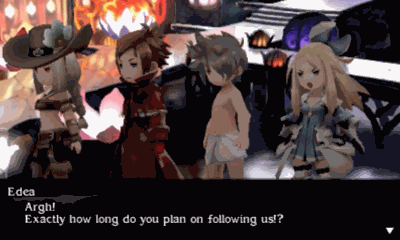
The above was a possibility. Or this…
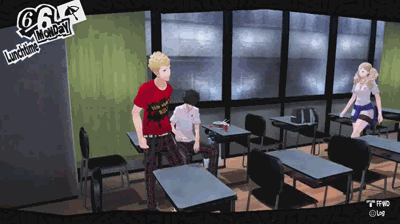
Hell, you could even see it happen in real time as the Xenosaga franchise gradually lost its budget…
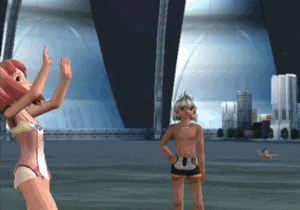
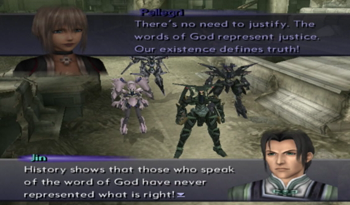
Now, is either way right or wrong? I am not going to make that determination. Personally, I have issues with getting bored by the “talking heads” of recent Persona titles, and, when they make the jump to action games (like the fighting, rhythm, and “strikers” spin offs), I find the text crawl downright insulting. I am playing a videogame! Please limit your visual novels to 30 seconds between levels! It worked for Ninja Gaiden! You can have these idiots talk a little less if they are going to be effectively motionless while I am supposed to…
… Er-hem.
I said I am not going to judge which is better. Persona or similar titles may have presentation issues when they are just throwing static text at a player, but these games are also 80-hour experiences that would not be able to exist if they required full-on mocap for every conversation about how we’ll never discover the true identity of the killer who is probably not standing right over there oh wait he is that is super convenient. Videogames are amazing pieces of art that are also beholden to investors, budgets and deadlines. I would rather have Bravely Default in my life than a “coming soon” JPEG and a thousand twitter followers conjecting how the real Bravely Default will become Final Fantasy 22 and Nomura will never tell us why.
But as far as the “movie” JRPGs? They’re great! They are fun, interactive stories that often include other ways to wring amazing gameplay out of a giant budget. Final Fantasy 15 may have created a “Cindy” that exists exclusively in the world of swimsuit model motion capture, but each of the boys were very controllable when cruising around Insomnia’s outer rim. I have absolutely no qualms stating that JRPGs can be good if they are using “movie” presentation or “static text” presentations.
But JRPGs seem to have completely forsaken the middle ground of their ancestors. They don’t make ‘em like Wild Arms 3 anymore.
Wild Arms 3 is a very text-based game. This is not simply a matter of noting that no one is voice acting this dialogue, what is significant is that, as the game progresses, we will experience any number of info dumps that feature discussions on imaginary biology, planetary conquest, and (everyone’s favorite PS2 plot MacGuffin) nanomachines. In other words, Wild Arms 3 is filled to the brim with the kind of nonsense that causes people to disparage Kingdom Hearts or the Xeno franchise. But something important happens here! There is direction!
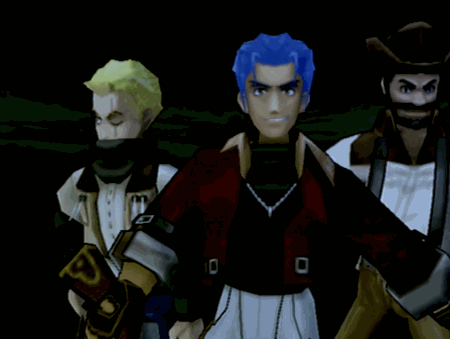
There is movement!
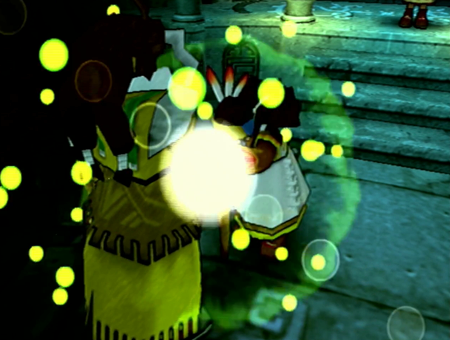
There is stuff happening!
And there are a lot of little things that not only would be impossible on older videogame systems, but also unlikely to appear in later, “better” productions. As an obvious example, Jet Enduro is an aloof jerk of a character, and barely says a word through much of Chapter 1. But you know everything you need to know by seeing this…
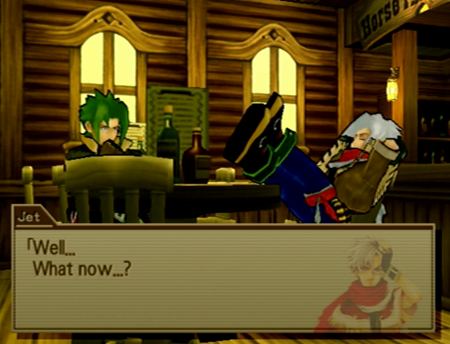
He is the exact kind of jackass that would put his shoes on the table. What is Jet’s mood right now? The simple act of sticking his boots over his head tells you everything you need to know. And you know that when the shoes hit the ground…
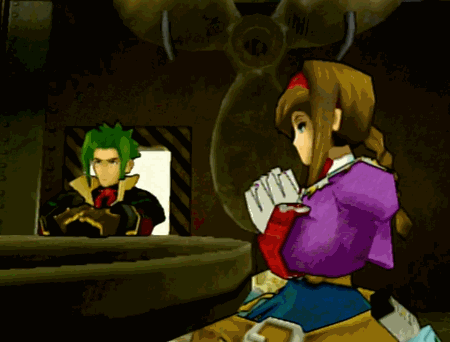
Something has hit the fan, and it ain’t pretty.
And it feels like we don’t get this kind of direction anywhere nowadays. Wild Arms 3 is the perfect middle ground between “we have more options than simple sprites that turn their heads” and “full on cinematic masterpiece”, and there are very few games that have ever occupied that space. Ultimately, you could describe several “classic” JRPGs as something almost like puppet shows: a middle ground between full-on acting and static talking heads. And looking back from the present when puppets have been forsaken for literally any other kind of presentation, Wild Arms 3 is one of the best puppet shows out there.
Wild Arms 3 is a beautiful unicorn in a field full of donkeys and horses, so keep an eye out for that horn as things progress into the next chapters…
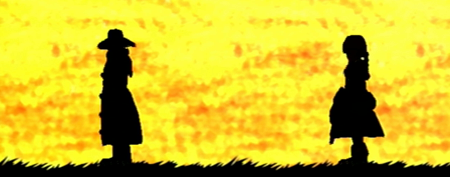
Next time on Wild Arms 3: Back to the Let’s Play proper as we head to the wrong side of the tracks.

[…] the point that one needed a magnifying glass and guide to figure out what was going on. In fact, as has been noted before, Wild Arms 3 has some extremely detailed and expressive models. However, it never hurts to see what […]